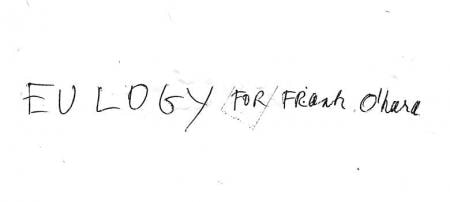
Larry Rivers delivered a eulogy for Francis “Frank” O’Hara that became one of the most infamous art world events of the late 1960s, but you’ve never heard of it. Artist Skylar Fein will read this eulogy, courtesy of the NYU Library Special Collections, and relate it to Rivers's work.
Fein makes the case that just as Rivers’s work prefigured Pop Art, the eulogy itself foreshadows the response to AIDS a few years later.
In the eulogy, Rivers asks that we forget O’Hara once won a lot of money on the “$64,000 Question,” forget that he painted Napoleon as "The Greatest Homosexual,” forget the scandalous Frank O’Hara Nude With Boots—even forget (if you can) that O’Hara was his lover and a world-renowned poet and a curator at MoMA at the time. Forget all of that. The topic is the eulogy. This is the speech Larry Rivers gave after O’Hara was run over and killed on a Fire Island beach.
“Larry’s eulogy was searing, cauterizing,” says Henry Geldzahler, then a young curator at the Metropolitan. “He took us out of our bodies, threw us first into the grave and then into the sky.” Rivers’s eulogy was graphic and explosive and ended with mourners yelling, “Stop! Stop!”
About Skylar Fein
How does a New York native become woven into the fabric of New Orleans? How does a medical student become a sought-after painter? How does catastrophe give birth to art? The answers lie in the work of Skylar Fein, an emerging artist whose sudden and surprising art career took root after Hurricane Katrina and flowered in the fall of 2009 at Prospect.1 New Orleans, the largest biennial of international contemporary art ever organized in the United States.
Fein was born in Greenwich Village and raised in the Bronx. He left New York for a career in Philadelphia, teaching nonviolent resistance under the umbrella of the Quakers. When a career in medicine called, he moved to Louisiana to take up pre-med work at the University of New Orleans. One week into school, Hurricane Katrina loomed, and Fein and his partner fled the city with little more than the shirts on their backs. They returned to find their house in ruins. Amazingly, they stayed.
In the wreckage of New Orleans, Fein began collecting the weathered wood that was lying everywhere. And in his backyard, he began putting the boards together, experimenting with color and composition. It was his first stab at art in any medium. But his work soon became known for its pop sensibility as well as its hard-nosed politics. After a few starring roles in group shows, he had his first solo show in May 2008 at Jonathan Ferrara Gallery in New Orleans. He dropped out of school to make art full time.
Fein’s Prospect.1 installation threw a spotlight on an overlooked piece of New Orleans history: a fire that swept through a French Quarter bar in 1973, killing everyone inside. The worst fire in New Orleans history has never been solved. His installation, "Remember the Upstairs Lounge," walked visitors right through the swinging bar doors and offered visual riffs on politics and sexuality circa 1973. The piece was praised in Artforum and the New Yorker, among others.
Fein’s first solo museum exhibition, Youth Manifesto, was an ode to punk rock as a force for social and cultural upheaval. The opening reception at the New Orleans Museum of Art was shut down due to police responding to the look of the unlikely art-going crowd.
Well known locally, Fein's work is now getting attention at the national level. His "Youth Front" project made waves at Volta New York (March 2010) with its blistering social criticism. In the massive installation "The Lincoln Bedroom" (November 2013) Fein recreated Abraham Lincoln’s first house in Springfield, Illinois, building a two-story 1840s frontier structure in the atrium at C24 Gallery in Chelsea, New York.